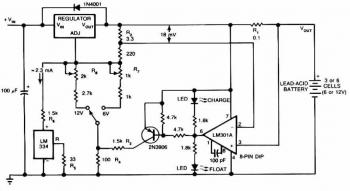This circuit gives an initial voltage of 2.5 V per cell at 25℃ to rapidly charge the battery. The charging current decreases as the battery is charging, and when the current drops to 180 mA, the charging circuit reduces the output voltage of 2.35 V per cell, leaving the battery in a fully charged state. This lower voltage prevents the battery from overcharging, which would shorten its life.
The LM301A compares the voltage drop across R1 with an 18 mV reference set by R2. The comparator’s output controls the voltage regulator, forcing it to produce the lower float voltage when the battery-charging current, passing through R1, drops below 180 mA. The 150 mV difference in between the charge and float voltages is certainly set by the ratio of R3 to R4. The LEDs present the state of the circuit.
Temperature compensation assists stop overcharging, especially when a battery goes through wide temperature changes whilst becoming charged. The LM334 temperature sensor ought to be placed near or on the battery to lower the charging voltage by 4 mV/℃ for each cell. Because batteries require far more temperature compensation at lower temperatures, alter R5 to 30Ω for a tc of -5 mV/℃ per cell if application will see temperatures beneath -20℃.
The charger’s input voltage need to be filtered dc that's at the very least 3 V greater than the maximum required output voltage: approximately 2.5 V per cell. Choose a regulator for the highest possible current required: LM371 for 2 A, LM350 for 4 A, or LM338 for 8 A. At 25℃ and with no output load, adjust R7 for a VOUT of 7.05 V, and adjust R8 for a VOUT of 14.1V.

Comments